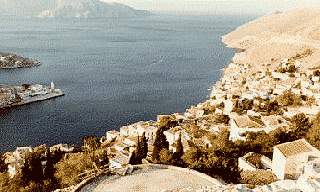Symi is a member of the Dodecanese group of islands and lies 24 nautical miles to the north east of Rhodes and 255 miles from Piraeus. Its area is 67 square kilometres (26 square miles), with many bays and headlands. Since the island is mountainous and arid, the majority of its inhabitants used to be employed in the sponge industry, shipping, fishing, shepherding and very small scale farming. Nowadays the majority are engaged in tourism, commerce and crafts, such as carpentry and boat - building. Its climate is dry, temperate and healthy, creating suitable conditions for ideal holidays. The history of the island begins in ancient and mythological times. Its ancient names were Aigli, Metapontis and Cariki. It is postulated that its first inhabitants were the Carians and the Leleges.  Symi is mentioned in The Iliad: King Nireus took part in the Trojan war with three ships. Herodotus refers to her as being a member of the Dorian Hexapolis (6 cities).
Symi is mentioned in The Iliad: King Nireus took part in the Trojan war with three ships. Herodotus refers to her as being a member of the Dorian Hexapolis (6 cities).
From 480 B.C. Symi belonged to the Athenian League. In the Roman and Byzantine epochs her fortune was closely linked to that of Rhodes. From 1309 the island entered upon a prosperous period with the development of shipping, commerce, the sponge trade, boat - building and other crafts. This period also saw the beginning of her increase in urban growth, the beauty of which remains intact to this day. The houses began to spread out from the castle area, and at the same time people started to abandon many of their traditional settlements.
The majority of the churches were also built during this time. Turkish attacks were repulsed in 1457 and 1485. In 1522, realizing that further resistance was in vain, and attempting to preserve as much as they could; the people offered gifts to the sultan and gained the grant, of many special privileges. Thus they achieved freedom of religious expression and the use of their own language. With the resulting advances in education and crafts.
In addition to these privileges, they won sponge fishing rights throughout all the seas of the Ottoman Empire. They supported the national war of independence and contributed funds to the Greek fleet over a number of years; not to mention financial assistance to Laskarina Bouboulina, Admiral Miaoulis, Themelis and others. In 1832 Symi unwillingly returned to Turkish control, and people reacted most strongly to this, in 1869 there was an attempt to abrogate the special privileges; In 1875 and 1885 there were population censuses: in 1908 Symi won her second battle to preserve her privileges, resulting in victory for the other islands as well. In 1912 Turkish dominion gave way to Italian control, which lasted until September 17th, 1943. From that date the island changed hands several times between the British and the Germans, the British taking Symi for the third time on September 25th 1944; on which day the castle and the surrounding quarter of town were blown up. On May 8th,1945 the German surrender of the Dodecanese was signed on Symi. On April lst,1947 a British Military Administration handed over to a Greek one, and on March 7th, 1948 the Dodecanese were incorporated into the Greek state.
 Symi is mentioned in The Iliad: King Nireus took part in the Trojan war with three ships. Herodotus refers to her as being a member of the Dorian Hexapolis (6 cities).
Symi is mentioned in The Iliad: King Nireus took part in the Trojan war with three ships. Herodotus refers to her as being a member of the Dorian Hexapolis (6 cities). From 480 B.C. Symi belonged to the Athenian League. In the Roman and Byzantine epochs her fortune was closely linked to that of Rhodes. From 1309 the island entered upon a prosperous period with the development of shipping, commerce, the sponge trade, boat - building and other crafts. This period also saw the beginning of her increase in urban growth, the beauty of which remains intact to this day. The houses began to spread out from the castle area, and at the same time people started to abandon many of their traditional settlements.
The majority of the churches were also built during this time. Turkish attacks were repulsed in 1457 and 1485. In 1522, realizing that further resistance was in vain, and attempting to preserve as much as they could; the people offered gifts to the sultan and gained the grant, of many special privileges. Thus they achieved freedom of religious expression and the use of their own language. With the resulting advances in education and crafts.
In addition to these privileges, they won sponge fishing rights throughout all the seas of the Ottoman Empire. They supported the national war of independence and contributed funds to the Greek fleet over a number of years; not to mention financial assistance to Laskarina Bouboulina, Admiral Miaoulis, Themelis and others. In 1832 Symi unwillingly returned to Turkish control, and people reacted most strongly to this, in 1869 there was an attempt to abrogate the special privileges; In 1875 and 1885 there were population censuses: in 1908 Symi won her second battle to preserve her privileges, resulting in victory for the other islands as well. In 1912 Turkish dominion gave way to Italian control, which lasted until September 17th, 1943. From that date the island changed hands several times between the British and the Germans, the British taking Symi for the third time on September 25th 1944; on which day the castle and the surrounding quarter of town were blown up. On May 8th,1945 the German surrender of the Dodecanese was signed on Symi. On April lst,1947 a British Military Administration handed over to a Greek one, and on March 7th, 1948 the Dodecanese were incorporated into the Greek state.

